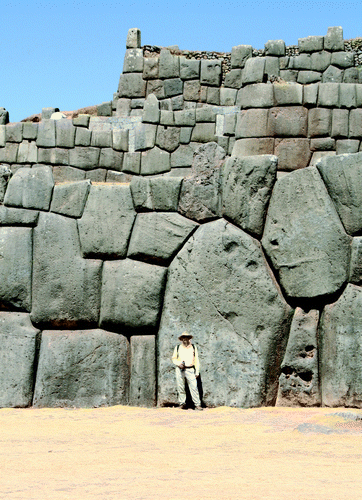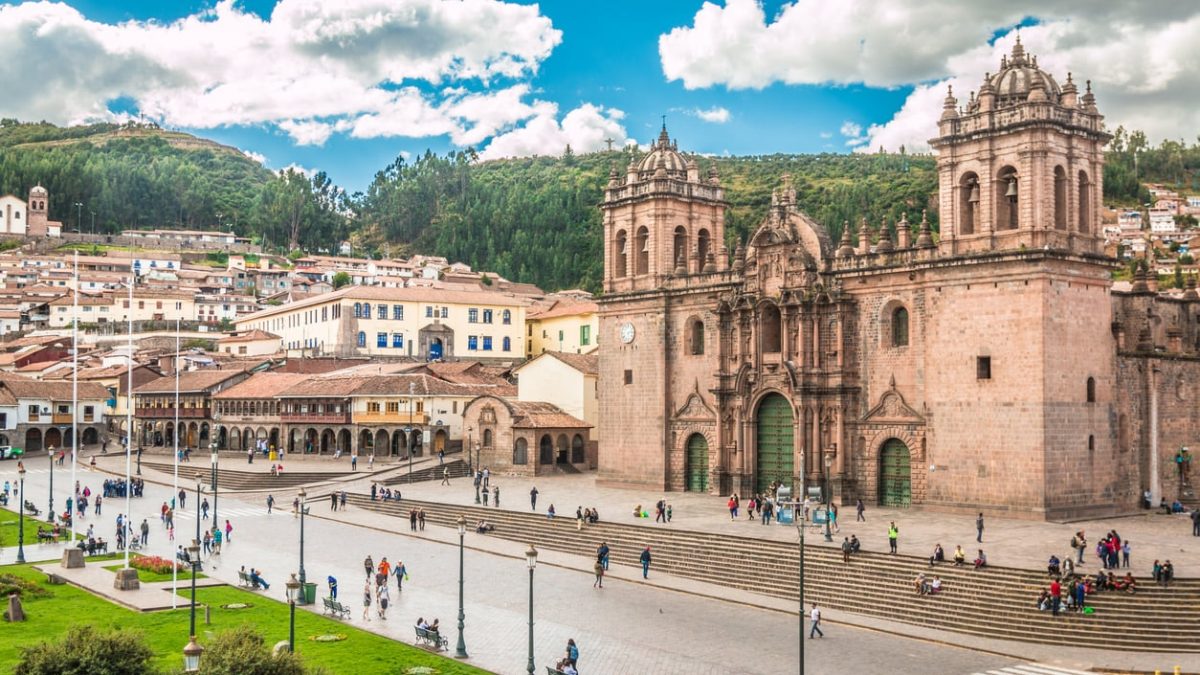The Cuzco Cathedral, completed in 1654, is the most prominent display of colonial architecture in the City of Cuzco, Peru. Located in the heart of the city, the Spanish constructed the cathedral on top of a site that originally held an Inca palace, a palace that was demolished by an earthquake in the early 1650s1. The cathedral, as can be seen in figure 1 below, is recognized by two large bell towers on either end, a strongly formal stone base, and a decorative centralized entry into the cathedral. Baroque influence is clearly evident in the architectural style, and combined with selective elements of native architecture in an attempt to create a new architectural style representative of both the Spanish and the natives of the city. However, this essay is not about discussing the purely architectural aspects of this grand structure. Instead, the Cuzco Cathedral will be discussed as an instrument that used religion as a means to implement colonial power over a city and the resulting impacts of these ideologies on the existing culture. As such, I will be discussing the importance and meaning behind the location of this building, materials used, and other methods of altering the religious identity of the city that led to the predominance of Catholicism in Cuzco.

When taking over the city of Cuzco, the Spanish restructured the city to lay claim to the land. This involved inscribing markings in performative settings2 and assigning Spaniards possession of homesteads in Cuzco. The earlier inhabitants, the Inca, were displaced to small surrounding towns3. The Huacaypata, an existing square in the city with significant religious meaning for the Inca people, was designated to become the heart of the new colonized city. A major planning move for this square was to construct a Catholic cathedral facing onto this plaza in the location of an existing palace4. The palace was one of many buildings on this square that had been reassigned new purposes by the Spanish. In order to avoid conflicts with the natives in the city, possession and alterations of these buildings were put on hold for at least five years5. This was intended to reduce the blow of colonization, but in no means made it less effective.
In this restructuring of the city, it is important to understand how the Spanish undermined the incredible achievements made by this group of people. Their failure to recognize this existing culture as impressive as it was seemed to have provided justification for the colonization that took place and the dissemination of the existing religion. This mindset allowed the Spanish to demolish key existing religious structures, such as Saqsaywaman. Saqsaywaman was an Inca temple and is believed to have been a temple for the sun. This temple is said to have once housed all items imaginable to the Inca people, and thus was a stronghold for keeping all warfare and military items as well6. This was an incredibly important temple to the Inca people, however, the Spanish dismissed this complex structure as merely a fortress that once existed to protect the Inca people7. This way of reducing the importance, or intentionally ignoring its importance, may have helped the Spanish justify its dismantling. The temple was constructed of polygonal masonry in the traditional Inca construction8. As can be seen in figure 2 below, these large masonry stones are carefully crafted to fit into each other so tightly that no additional support or connections are required. Seeing these already smooth stones as a resource to be extracted, Spanish colonizers used massive amounts of local labour to mine Saqsaywaman of its materials and build their new city of Cuzco. “There is indeed not a house in the city that has not been made of this stone, or at least the houses built by the Spaniards.”9 These stones were not limited to constructing houses, but was a critical material component that comprised the walls of the Cuzco Cathedral, also built by native labourers10.

Saqsaywaman remains as a ruin today, and the stones that remained would have been too labour intensive and costly to remove and integrate into the new Spanish city. Despite the Spanish’ recognition of the impressiveness of these structures, there was no attempt to understand the Inca’s method and reasoning for this construction. Instead, they often diminished these impressive techniques by noting technological insufficiency and lack of proper tools11. This helped strengthen a view from the Spanish that the people in Cuzco needed European colonization to become a better, more sophisticated society.
However, despite their attempts to remove the Inca religion by destroying religious sites, the Spanish continued to struggle with fully removing the nature of this existing religion from the city. The pre-Hispanic Inca believed in many sacred things, and these things often took the form of landscape features, rocks, or other notable natural objects. However, the Inca valued these things based on their essence, or kamay, and less on what the actual physical appearance of the sacred object was12. This was not an easy concept for the Spanish to understand. One example of trying to replace this religion focused on dismantling Huacaypata. This central plaza was covered in sand and sacred to the Inca. When the Spanish discovered that this sand was considered sacred to the indigenous people, they tried to eliminate its significance to the people by using it for mortar in the construction of the cathedral. Despite this change of form, the sand still had its original essence that was still considered holy to the indigenous people13. This sand still lives today in the walls of the cathedral, holding together the stones mined from Saqsaywaman, echoing the irony of the religious struggle between the Spanish and Inca.
Another approach taken by the Spanish to integrate Catholicism was to introduce a system of integration coming from respected native people and working its way down. During the initial colonization of Cuzco, Christian church authorities were known to put noble Incas in charge of cofradías, a group of members focused on religious charity in the community. It could be seen that by putting native people in this position, it would help incline the rest of the population to follow their elders and adopt a new religion14. This, in combination with the strategic placement of local churches, aided in converting a mass population into a Christian religion, and allowed the Spanish to gain greater control of this city.
Though discouraged by church authorities, these cofradías were known to include Inca related items in Catholic iconography15. Despite their dissent, these depictions in religious works became important in the integration of Catholicism in Cuzco, giving the population a sense of inclusion and belonging. An example of this can be seen in figure 3 below, the statue of the Christ of Earthquakes. This statue, housed in the cathedral, was made of locally found and made materials, and was constructed in the late 1500s. What is interesting about this particular statue, however, is how it changed significance and assimilated into the culture over the years. One particular example is that it was originally constructed with a stiff loin cloth. By the time of construction of the cathedral, the garments of this statue had taken a shift to a more familiar native garment, the sudario16. Further to this, the statue was of significant importance to the people during the 1650s earthquake, and believed to have put an end to the tremors. As a result, the statue became part of an annual procession held by the people out of respect and celebration17. Catholic practices of serving and worshipping were not totally foreign to the native peoples. In both the Inca religious practices and in Catholic practices, “both the saint and the ancestor depended on an organized structure to keep their memory alive,”18 with both involving rituals, art and citations. This, in combination with reassurance from noble Incas, is likely a reason why the introduction of Catholicism had such a stronghold on the city of Cuzco under Spanish colonization.

The Cathedral of Cuzco represents an amalgamation of these two very distinct people groups, the Spanish and the Inca, and their respective religions. From strategic locations in attempts to dismantle the footholds of a previously thriving religion to the slight adaptations of religious emblems and artwork, this cathedral is an example of a very complicated history. It showcases a resiliency in the city that struggled with the enforcement of a new religion onto a community, and this community in turn finding ways to still find their foundational beliefs within it. There is a complex history linked to this structure, and this struggle is literally baked into its walls.
Endnotes
1Carlos F. Brillembourg, “Renaissance and Mannerist Architecture in the New World.”
2Sabine MacCormack, “History, Historical Record, and Ceremonial Action: Incas and Spaniards in Cuzco.” Comparative Studies in Society and History, vol. 43, no. 2 (2001), pp. 329–363, 343.
3MacCormack, 343.
4MacCormack, 343.
5MacCormack, 344.
6Carolyn Dean, “Rock in Ruins.” A Culture of Stone (2010), pp. 143-178, 145.
7Dean, “Rock in Ruins.”, 145.
8Dean, “Rock in Ruins.”, 145.
9Dean, “Rock in Ruins.”, 146.
10Dean, “Rock in Ruins.”, 147.
11Dean, “Rock in Ruins.”, 147.
12Carolyn Dean, “Introduction.” A Culture of Stone (2010), pp. 1-24, 4.
13Dean, “Introduction.”, 5.
14Martín Oliver Carrión, “Surviving Conquest: From Huacas to Cofradías in 17th Century Cuzco.” MLN, vol. 134, no. 2 (2019), pp. 324–350, 332.
15Carrión, 347.
16Maya Stanfield-Mazzi, “Cult, Countenance, and Community: Donor Portraits from the Colonial Andes.” Religion and the Arts, vol. 15, no. 4 (2011), pp. 429–459, 442.
17Stanfield-Mazzi, 442.
18Carrión, 339.
Figures List
Feature Image | “Cusco: At the Heart of the Inca Empire.” Skyticket Travel Guide, skyticket.com/guide/3759.
Figure 1 | “Cusco Cathedral.” Freepik, 15 July 2019, www.freepik.com/premium-photo/cusco-cathedral_5000613.htm.
Figure 2 | Dean, Carolyn. “Inka Ruins and the Discourse of Mystery.” Third Text, vol. 25, no. 6, 2011, pp. 737–749., doi:10.1080/09528822.2011.624348.
Figure 3 | Stanfield-Mazzi, Maya. “Cult, Countenance, and Community: Donor Portraits from the Colonial Andes.” Religion and the Arts, vol. 15, no. 4, 2011, pp. 429–459., doi:10.1163/156852911×580784.
Works Cited
Brillembourg, Carlos F. “Renaissance and Mannerist Architecture in the New World.” Encyclopædia Britannica, Encyclopædia Britannica, Inc., www.britannica.com/art/Latin-American-architecture/Renaissance-and-Mannerist-architecture-in-the-New-World.
Carrión, Martín Oliver. “Surviving Conquest: From Huacas to Cofradías in 17th Century Cuzco.” MLN, vol. 134, no. 2, 2019, pp. 324–350., doi:10.1353/mln.2019.0020.
Dean, Carolyn. “Introduction.” A Culture of Stone, 2010, pp. 1–24., doi:10.1215/9780822393177-002.
Dean, Carolyn. “Rock in Ruins.” A Culture of Stone, 2010, pp. 143–178., doi:10.1215/9780822393177-006.
MacCormack, Sabine. “History, Historical Record, and Ceremonial Action: Incas and Spaniards in Cuzco.” Comparative Studies in Society and History, vol. 43, no. 2, 2001, pp. 329–363., doi:10.1017/s0010417501003516.
Stanfield-Mazzi, Maya. “Cult, Countenance, and Community: Donor Portraits from the Colonial Andes.” Religion and the Arts, vol. 15, no. 4, 2011, pp. 429–459., doi:10.1163/156852911×580784.
